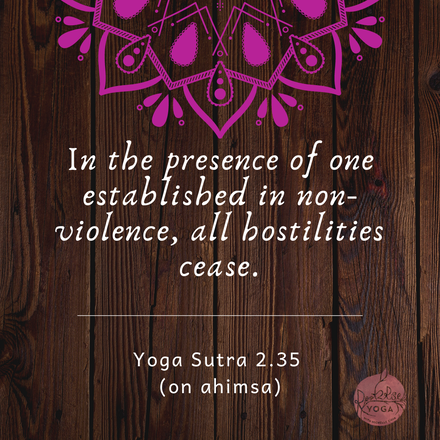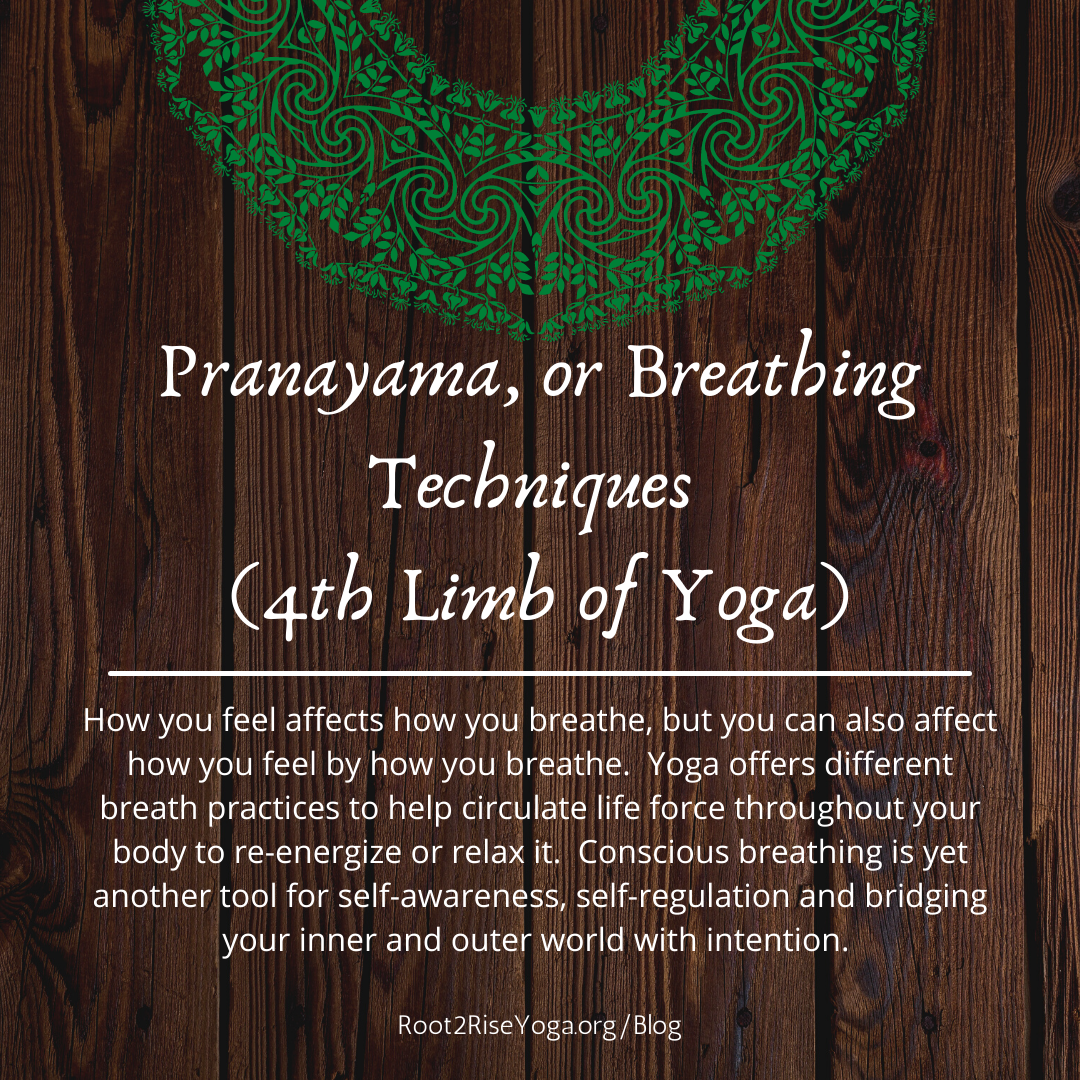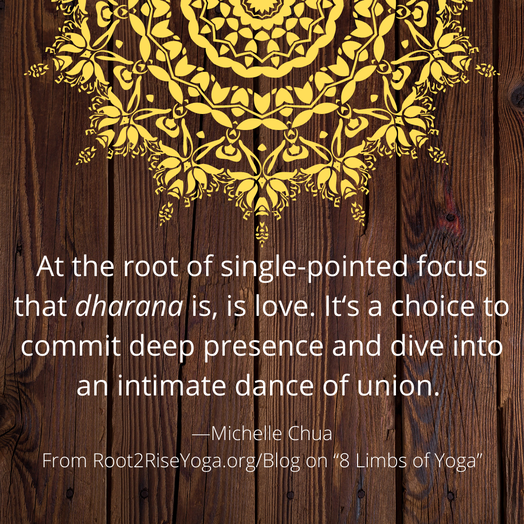|
Whether you're new to yoga or have been practicing a while, the 8 Limbs of Yoga are the 8-fold path explained in the Yoga Sutras of Patanjali and combine to form a well-rounded practice for mind, body and spirit. Beginning January 4, 2021, I'll be adding to this article each week for a total of 16 weeks exploring these foundations. Consider joining our yoga community live online on Zoom for yoga classes that further this exploration through direct experience simultaneously. The 1st Limb of Yoga, the YamasThere are 8 Limbs of Yoga and these are the aspects that make up the practice of yoga, which means union. The first limb, called the Yamas in Sanskrit, are a list of five ethical behaviors that guide our actions in the world to align with our yogic path to Self-realization, or uniting with our true nature, that of pure love. The 1st Yama, Ahimsa (Nonviolence)The first Yama is nonviolence, or ahimsa in Sanskrit. There are many ways we can consciously and unconsciously inflict pain and suffering on ourselves, others and our planet. To practice non-harm, I believe it’s essential to observe our thoughts, words and actions and the effects they have on ourselves and the world around us. What is the tone of your inner voice as you move about your day? How do you relate to the feelings and needs of others? How are your daily actions affecting the well being of your body, spirit, mind, household, loved ones, neighbors, communities, cities and all life around you? In our interconnectedness what you think, say and do matters and its energy ripples; Ahimsa is the practice of rippling kindness, compassion and love. The Yoga Sutras state that as one fully embodies non-violence, their presence of peace emanates an energy field of peace around them, so that lower frequencies of hate, violence or destruction dissolve within that field. There is power in kindness! The 2nd Yama, Satya (Truthfulness)Our thoughts and words have creative power. When they are misaligned to what we do and say, we feel (and others may feel) the state of imbalance and confusion. Just as we consciously align our bodies in yoga poses, yoga includes aligning our minds, bodies and spirits so that our actions in our outer world match our inner intentions. Living with such clarity and integrity we can live wholeheartedly, expressing our truth with ahimsa. The 3rd Yama, Asteya (Nonstealing)The 3rd yama is asteya, non-stealing. When I think of the mindset that might motivate someone to steal an idea, an object, a relationship, someone’s time, natural resources or whatever it may be, I feel it boils down to a feeling of scarcity and undervaluing their own abilities and so-called possessions. To me, it seems they may not understand their own power to access their own creativity, abundance, uniqueness or resources. This may lead to competitiveness and even greed, and it’s based on illusions of the ego like, “There’s not enough for everyone” or “I’m not good enough.” Interestingly, as we adhere to non-harm (ahimsa) and truthfulness (satya), we release the need to steal what does not belong to us. Moreover, we can honor the balance of giving and receiving in our relationships when we connect to the truth that we are all part of a whole, like we’re ultimately on the same team. Thus, we realize that the harm we inflict or generosity we share towards another being is ultimately what we are doing to ourselves too. In practicing asteya, here are some questions to reflect on:
The 4th Yama, Brahmacharya (Wise Use of Energy)The 4th yama is brahmacharya, or wise use of energy. How do you practice moderation and balance in all areas of your life in order to harmonize with divine consciousness, consequently experiencing pure vitality? Interpreted by some to include celibacy, brahmacharya involves being mindful with how you spend your energy—your thoughts, time, attention, physical presence, emotions, finances and other resources—with the ultimate intent to align with infinite intelligence. It also includes providing your body with clean nourishment and sufficient rest and engaging in a balance of contemplative solitude and socializing and work and play. It’s being purposeful with how you harness, contain and expend your energy in light of the bigger picture of your spiritual journey. Consistent practice of daily pranayama (breathwork), asana (postures) and meditation set the stage for cultivating brahmacharya. The 5th Yama, Aparigraha (Non-attachment)The 5th yama is aparigraha, or non-attachment, non-possessiveness and non-greed. In understanding the impermanence of all material things, you can enjoy the freedom of being present without seeking to relive the past or leap into the future, of being able to let go of things when their time is up, such as relationships you may have outgrown, and of self-confidence without having to compare yourself to others because you can value the success of each being as a uniquely beneficial part of the whole. It's also the ability to be grateful for what you have and enjoy an inner sense of fulfillment, without having to constantly chase after something else to fill a void. There are many ways to apply aparigraha, and ultimately, it enables a sense of liberation to be fully authentically you without having to rely on someone or something else to feel your worth. As Gurudev Sri Sri Ravi Shankar explains aparigraha, “Non-accumulating simply means confidence in one’s existence and in one’s abilities. It is knowledge of oneself.” And in the words of Lao Tzu, “When I let go of what I am, I become what I might be. When I let go of who I am, I receive what I need.” The 2nd Limb of Yoga, the NiyamasThe niyamas are constructive tools to live in harmony with ourselves and strengthen our alignment with our core being. Whereas the yamas of the 1st Limb of Yoga encompassed ways of interacting with the world to reflect our true nature, the niyamas are personal practices in relating with our self within. The 1st Niyama, Shaucha (Cleanliness)The first niyama is shaucha, often translated from Sanskrit as “purification, or cleanliness.” It involves healthy habits of keeping our bodies and environment clean and our minds free from harmful thoughts. In relation to the body, it’s being mindful of what you put inside and on your body to optimize its wellbeing and ability to be a temple for your inner spirit. For your environment, it’s clearing away clutter and maintaining a physical space around you—at home, in your car, at work or in nature—that is conducive to open energy flow, peaceful interactions and inner calm. And for your mind, it includes practices like regular meditation and discerning what you focus on to develop clear perception, living consciously and evolving in awareness. Some self-inquiry to guided your practice of shaucha might be…
The 2nd Niyama, Santosha (Contentment)The second niyama is santosha, often translated as “contentment.” As Willem Kuyken, professor of mindfulness as Oxford University, explains, contentment is a state of being that has the capacity to be present with the gamut of experiences, from those deemed joyful to challenging and difficult, with the wholeheartedness and spaciousness of equanimity. It’s letting go of conditions and expectations, like “I’ll be happy when or if…” and not resisting what’s here now nor perpetuating suffering or drama through internal storytelling, such as those based on presumptions that cloud perception. There are several ways to develop santosha. The complementary yogic practice of vairagya, or non-attachment, can help cultivate santosha by understanding and remembering the impermanence of all material things. In yoga asana (or postures), meditation and daily life activities, you can observe your mental storytelling, reactions and expectations and develop the discernment, known as buddhi in yoga psychology, to see how they actually relate or don’t relate to the situation being interpreted. Identify when you might be filling in the blanks spurred by personal aversions or insecurities, such as false beliefs of “I’m not good enough.” Also, a genuine practice of gratitude throughout the day can help redirect inclination of mind towards seeing what IS working really well in your life, body or relationships. Just as negative thoughts can become a default, positive thoughts can become the overriding habit too, as is the effect of the yogic practice of pradhipaksha bhavanam, or transforming negative thoughts to their opposite. Finally, contentment is not to be faked or used as a guise to overlook darkness and vulnerabilities. Kuyken teaches the mindfulness practice of befriending, that is, cultivating a caring curiosity to be with all that life brings, without having to fight against, take flight from or numb yourself to what is. Just like many of the yamas and niyamas, santosha redirects our attention inward to our true source of contentment, rather than riding the falsehood that a thing or other being will create happiness for us. The 3rd Niyama, Tapas (Discipline)The 3rd niyama is tapas, often translated as the fire of discipline. It is the diligent effort required to commit to day-to-day and moment-by-moment practices that uncover our greatest potential, our highest Self or our true nature. It is the choice to show up and do our best, even when the conditions are challenging, like when we feel we’re too busy, knowing also that “our best” varies in expression based on our current state of being. It’s the persistence to honor our truth and address the habits that no longer serve us. This includes having the courage and willpower to practice shedding harmful thought patterns, likened to a fire of purification, and to begin healthier habits. As we directly experience the effects of long-term discipline to cultivate our healthiest mind, body and spirit, we strengthen our discernment in everyday life to choose consciously how we develop, clearly direct and sustain our life force energy so that we live in alignment with our life purpose. As one of my teachers, Kia Miller, encouraged, “Transform your discipline (an attitude of obligation) into devotion (an attitude of loving surrender)”. The 4th Niyama, Svadhyaya or Self-StudyThe 4th niyama is svadhyaya, often translated as the study of the self. This involves observing your habits of thinking, doing and being to deconstruct barriers to aligning with your highest consciousness. It also includes studying wisdom teachings, such as the Yoga Sutras, learning from enlightened teachers and practicing mindfulness to expand your perspective of life. In yoga philosophy, there is a distinction between the “self” (all lowercase) as the ego self and sense of individuality and the “Self” (with uppercase “S”) as universal consciousness that knows no separation between all beings. Through cultural conditioning, inherited traits and personal habits, the ego self is mostly concerned with its own survival and is often driven by fear. Fueled with satya (truthfulness), ahimsa (nonharm) and tapas (discipline), svadhyaya is learning to let go of such conditioned behaviors or beliefs to transcend the ego and discover unity consciousness, which is characterized by pure connection and deep love. As Sufi poet Rumi encouraged, “Your task is not to seek for love, but merely to seek and find all the barriers within yourself that you have built against it.” And, as the ancient Hindu text and source of yoga philosophy, The Bhagavad Gita, explained, "Yoga is the journey of the self, through the self, to the Self (with a capital S)". The 5th Niyama, Isvara Pranidhana or Surrender to the DivineThe 5th niyama is isvara pranidhana, often translated as surrendering or offering of one's efforts to the Divine. The divine is your concept of God, which is named in different ways in different cultures but is essentially One to which all beings are connected: Higher Self, Universal Intelligence, Pure Love, a deity that embodies Greater Consciousness, etc. Surrendering or offering one's efforts is the attitude of devotion and setting aside the your ego to be a conduit of divine love. Isvara pranidhana, can take the form of daily offerings of personal ritual, like a daily yoga practice dedicated to seeing the interconnectedness of Life and all beings, a personal prayer when you awake or anonymous acts of kindness as tokens of gratitude. It involves leading from the heart and being open to the flow of life's dynamics, rather than gripping onto expectations of how things should be or your notions of who's right and who's wrong. Through consistent loving presence and intent to be an instrument of love and peace, you humbly embrace your true identity, and each other's true identity, as Divine too. The 3rd Limb of Yoga, Asana or PosturesThe 3rdLimb of Yoga is Asana, or the physical postures. The Yoga Sutras of Patanjalidefines asana as a comfortable and steady pose. Such qualities are determined not by the poses we choose to practice, but by our approach to them. A teacher once taught in a yoga asana class that the way you practice your postures conveys much about the way you handle life and its situations. As we approach poses we find naturally easy for our bodies, we can develop a humble curiosity that sparks presence of mind rather than letting our thoughts wander with our bodies in “auto-mode.” As we approach challenging poses, we can cultivate a steady effort coupled with an ease of surrendering attachment to fear or expectation. Through our physical yoga practice, we can cultivate equanimity of mind as we simultaneously strengthen and open our bodies. My Yoga Psychology teacher, Ashley Turner, points out that the poses themselves help to deconstruct harmful mental-emotional patterns held in our bodies. In daily life, we repeatedly respond to stimuli, such as stress, psychologically and physically in our postures and gestures. When we consistently practice asanasthat take us out of those postural habits, we can restructure our own bodies’ alignment and help release the psychological imprint held there. We affect our subtler energetic body. Ultimately, however, the Yoga Sutrasrelays that the main purpose of the asanapractice is prepare our bodies and minds for the next limbs of yoga, especially to be still in meditation. The 4th Limb of Yoga, Pranayama or BreathworkAs you’re reading this, what is the quality of your breathing right now? How you feel affects how you breathe. Different emotions, such as anger, sadness, joy or shock, can shift the way you breathe often instantaneously. Inversely, you can affect how you feel with how you’re breathing. When you realize your breath becoming erratic because you’re nervous or fearful, consciously deepening and slowing down your breath can help tone down the stress response of your nervous system and help you to feel grounded and calm. The breath is a powerful tool for bridging the body and mind. Pranayama, the 4thLimb of Yoga, is mindful breath techniques. There are a variety of breathing practices that when used skillfully, help regulate the flow of prana, or life force, throughout your body. Techniques, such as Kapalabhati Pranayama, or Breath of Fire, can help energize and warm your body and stimulate digestion and abdominal muscles, while Nodhi Shodhana, or Alternate Nostril Breathing, can help to relax your body and mind and is said to aid in balancing the left and right hemispheres of the brain. As you become more attuned to your breathing patterns and affecting them, you also develop greater attunement with your subtler layers of being, such as your energetic layer, or Pranamaya Kosha, or mental-emotional layer, or Manomaya Kosha. Pranayamais a doorway to the inner dimensions of self, which you focus on in the subsequent Limbs of Yoga. The 5th Limb of Yoga, Pratyahara or Withdrawal of the SensesThe 5th Limb of Yoga is Pratyahara, often translated as “withdrawal of the senses” and “turning inward.” While the first four Limbs involved our external world and how we relate to it, this limb transitions our focus to our inner being. Wherever your attention goes, your energy flows. Pratyahara is a conscious choice to release yourself from being controlled by your senses and the stimuli they take in. Rather than passively receiving all sensory input, like when scrolling aimlessly on social media, you become intentional with what you’re digesting mentally. Instead of succumbing to late night junk food cravings, you skillfully decide how and when to nourish your body to enable optimal wellness of mind, body and spirit. You understand the influence of all that you receive through your senses both actively and subconsciously and take the reins of your perception of life. Consequently, you empower your freedom to experience deepening levels of meditation and mastery over your mind, as will be described in the subsequent Limbs of Yoga. The 6th Limb of Yoga, Dharana or ConcentrationThe 6th Limb of Yoga is dharana, often translated as concentration. It’s a prerequisite for meditation and is precluded by the ability to let go of outside distraction (that is, pratyahara). Have you ever felt so immersed in one thing that time seemed irrelevant? Perhaps it’s gardening, dancing, running, playing basketball or playing a musical instrument. Your one-pointed attention to the task, situation or being at hand feels almost effortless as you are drawn by a state of love. Positive psychology might call this a “state of flow,” and professional athletes might call it “being in the zone.” It’s a choice to commit your focus and presence on one thing for a duration of time. It’s a mindfulness practice and the opposite of multi-tasking, the latter in which your attention is dispersed into a variety of subjects. The result of dharana is an intimate meeting with the object at hand. The 7th Limb of Yoga, Dhyana or MeditationThe 7th Limb of Yoga is dhyana, which involves sustained concentration turned into meditation. Through consistent practice of meditation, such one-pointed focus allows the you a greater perspective than the limited conditionings, memories, fantasies, worries and sensory perceptions of your mind. You are able to see through the mind-doings of your ego with self-awareness, connecting with yourself as the seer or witness of your thoughts, emotions, actions and all your interactions with the outside world. Dhyana is the natural landscape for insight and wisdom to arise in which illusions of being separate from all entities fall. The 8th Limb of Yoga, Samadhi or Unity ConsciousnessThe 8th Limb of Yoga is samadhi, often translated as integration or absorption, in which the meditator and the object of meditation are unified. I call this unity consciousness, as it characterizes a state in which you deeply understand that you are, and everything is, part of a greater Universal Self. The ideas of separation, such as ways we differentiate between cultures, species, beings, another human, etcetera, dissolve, and effortlessly you attune to the greater wholeness of which all are a part. The Yoga Sutras states that the state of samadhi is not something you can strive for but rather let go to as a natural result of consistent meditation and practice of the other 6 limbs of yoga. You might touch glimpses of this state of deep love and interconnection when you are innocently immersed in belly laughter with a toddler or freely forest bathing among ancient trees, in which time seems irrelevant and you feel completely attuned to the essence of your being as the same essence of what’s around you. Samadhiis a bliss state that organically emerges through devoted authentic practice of all the subsequent limbs paired with loving surrender of expectation and ego identity. Diver deeper and integrate the 8 Limbs of Yoga through a series of recorded asana practices with dharma talks below:Comment below: What are your thoughts? How do you personally apply these limbs of yoga? What challenges have you faced in doing so?
0 Comments
Leave a Reply. |
A Collective Blog about Yoga Lifestyle & Inspiration
|
REviews of Root 2 Rise Yoga with Michelle chua:Michelle truly lives out what she teaches. She is so much more than a yoga teacher - I learned this when I went on her exquisitely curated trip that she organized to Costa Rica this past June 2018...Hopefully like me, you'll be delighted by her effervescent love of movement, nature, and all people! Michelle clearly stands out with her beautiful and bright energy. I love how her practice and teaching encompass body, mind and spirit. She not only teaches yoga but lives and exudes it. Michelle not only teaches 'yoga', she embodies it fully with her heart and soul... Michelle is by far one of the best instructors I've ever had, period. Patient, clear in her explanations and demos, and so encouraging... My first yoga class was with Michelle years ago. You can have the best (yoga pose) sequence and not teach from your heart. With Michelle, I also feel her passion when I'm in her class. I can see she loves what she does, and she inspired me to want to teach yoga, too. |
Let's connect:Now offering private reiki sessions for stress relief and healing.
I'm so grateful to have met Michelle! Her kind energy opened up my interest in pursuing yoga and meditation. She is such an incredibly light and soul. She starts with grounding ourselves through mindfulness and breathing exercise. She brings the most authentic energy to the class by sharing the history and understanding behind poses, names, and techniques. I truly appreciate her work and impact on my well-being! I’ve had dozens of instructors over the years, but Michelle is far and away the best yoga mentor I’ve ever practiced with. She epitomizes grace during these difficult times. Michelle has saved my sanity and my back while working from home, keeping me grounded with her sharing of yogic teachings and meditation techniques. Her repertoire of physical asanas is encyclopedic, and I’ve loved learning new poses and stretching my boundaries. Jump in, all. You’ve got this! |
©2010 Root 2 Rise Yoga














 RSS Feed
RSS Feed

